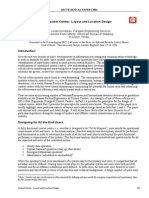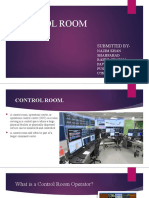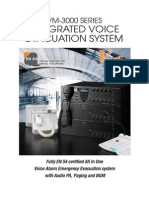Top
Considerations
When Designing an Ergonomic Control Room
�Control room planners are now
incorporating every aspect of human,
machine and environment interaction
Defined as the science of fitting
workplace conditions and job
demands to the capabilities of the
working population, by the Occupational
Safety and Health Administration, ergonomics sounds like a
simple match game between the employee and work
conditions. However, with all the factors that affect control
room ergonomics, it has become more about designing the
console around the employee.
To truly satisfy todays heightened ergonomic standards,
console design has experienced a dramatic shift to deliver
solutions that are smaller, with improved functionality and
more appeal than ever before. Current console design is done
with a more comprehensive, top-down approach to control
room planning, examining every element of the console
itself, as well as the overall layout of the room. Control room
planners are now incorporating every aspect of human,
machine and environment interaction, from monitor tilt and
indirect lighting to air temperature and movement, to create
the optimal working conditions and comfort level.
Planning and Design of a Control Room
Defining a Control Room
Put simply, a control room is a place where a facility or service
can be monitored and controlled. While the equipment in the
control room is essential to operation, to be effective, it has to
support the requirements of the operator. Its important to
keep in mind that while in a control room, a persons ability to
use their senses is diminishedwhich requires them to rely
on technology within the control room to determine what is
happening and/or what action needs to be taken.
Since the control room acts as a persons eyes and ears, the
design of it is extremely important. When designing a control
room, its critical to consider all factors, for example,
equipment selection, operating practices, working
environments and furniture choices. In addition to the design
of a workstation, operators within the control room must be
considered. The overall system will fail if operators are
overloaded, undertaking tasks for which they are poorly
trained or straining to read displays that are illegible. It is
necessary to identify the limitations of the operator to
minimize potential mismatches between user capabilities
and system demands.
�Control Room
Design Considerations
Room Architecture
Size and Layout
The control room itself is important because it serves as the
shell of the system. When selecting a room, designers should
consider the control room objectives and determine how
much equipment and people the room will house. The size
of the room should accommodate all necessary equipment,
while allowing for people to comfortably move about.
Physical layouts should also accommodate the use of
non-electronic equipment and documents, such as
operations manuals, log books, maps and clipboards. Space
should also be allowed for positioning such items as
telephones, keyboards, mice, controllers, radio/intercom
and writing areas.
Shape
In addition to size, there are a variety of room shapes. A
rectangular room provides the most options for equipment,
display and console positioning. In general, rooms with
sharply angled walls or with support columns should be
avoided. Designing a control room of the right size and shape
can go a long way toward achieving an efficient, comfortable
operating environment.
Materials
The room materials should also be considered. Ceiling
materials should offer moderate to high reflectance of 0.8 or
higher to improve light distribution throughout the room and
reduce energy cost. The ideal walls in a control room feature an
off-white matte or flat finish with a reflectance range of 0.5 to
0.6. Floor materials should have a lower reflectance of 0.2 to
0.3 for carpet or 0.25 to 0.45 for floor tiles.
Windows
Operators typically do not like working in windowless
environments. Unless prescribed for operational or security
reasons, it is strongly recommended that north-facing
windows are included in a control room, primarily for
psychological reasons. However, such light sources also
present potential security challenges and can contribute to
reflections and glare. Windows and doors should be out of
the primary field of view but visible from a seated position.
Also, it is important to allow circulation space around doors
to minimize congestion.
Aesthetics
Customized consoles with logos, images and designs allow
companies to create a one-of-a-kind console that highlights
their corporate identity. From a simple decal to an intricate,
multi-color Corian inlay, custom consoles provide a unique
control room solution.
WEB: winsted.com
info@winsted.com
EMAIL: info@winsted.com
800.447.2257
TEL:winsted.com
800.447.2257
�Consoles have extensive functionality advantages over basic office furniture.
Furniture
Consoles
When determining console placement in the control room,
it is important to consider the rooms dimensions, number of
stations, measurements of each station, video wall sizes and
aisle width.
For the ideal viewing angles, there should be little head
movement and minimal eye movement (maximum eye
movement is 35 degrees). It is critical to determine if the
workstation will be used as an isolated unit or in conjunction
with overview displays or other workstations. The height of
the console should be calculated so the smallest operator
can see over the top of any mounted electronics, walls or
displays, and the clearance beneath the work surface should
allow for the tallest operator to sit comfortably.
Maximum
Eye Movement
35
FOR BEST
VIEWING
ANGLE
For optimal viewing of a
large-screen display or group of
displays, the distance should not
be less than twice the displays
largest image height or greater
than six times its height for
normal video. However, if this is
the primary monitor and it should
fit into the 30 degree cone-ofviewing, then the longer-range
formula for viewing should take
precedence.
Planning and Design of a Control Room
It is critical to factor every type of situation and future
upgrade, not only day-to-day operations, when designing a
command control room. Sufficient space should be
maintained in and around the console to allow multiple
groups of personnel to view and analyze information quickly
and efficiently.
Flexibility is also key when considering console furniture.
Depending on the control room objectives, consoles should
be reconfigurable, allowing designers to move or install them
in multiple locations. Further, consoles that are easily
expandable are also useful for applications that require
various console size requirements.
Functionality
Oftentimes, many control room designers
weigh the differences between consoles
and office furniture, and argue that both
can be used interchangeably. However,
because the functions that take place within
the control room are so importantoften,
life or death decisionsconsoles have
extensive functionality advantages over
basic office furniture.
�Control room environments run
24 hours a day, 7 days a week
and put incredible stress on the
equipment in them.
CONSOLES OFFER THE FOLLOWING FUNCTIONAL
ADVANTAGES OVER OFFICE FURNITURE:
High Equipment Loads: Consoles are designed for handling
high equipment loads, including multiple monitors and
processors, while remaining ergonomically correct. Further,
these monitors can be configured in many different ways to
accommodate operators. On the other hand, traditional office
furniture is only optimized for one or two monitors, and the
addition of extra monitors reduces the ergonomic correctness.
Device Management: The other aspect of equipment load is
the management of processors and other peripheral devices.
Consoles keep processors safely behind closed, lockable
doors in the base of the console. This eliminates failure due to
equipment being knocked or wires being pulled out of
equipment. Traditional office furniture might offer a processor
holder, but it does not offer equipment protection.
Front and Rear Access: Control room consoles are built with
both front and rear access to processors and rack-mounted
equipment, allowing IT departments and other service
providers quick access for equipment repairs, replacements
or updates without disrupting the operations of the room.
Traditional office furniture does not provide full access,
requiring disruption to operations.
Device Management
Wire Management
24/7 Demand: Control room environments run 24 hours a
day, 7 days a week and put incredible stress on the equipment
in them. Consoles are built to withstand the rigors of this
type of use, featuring a steel substructure and high
performance materials that resist wear. Office furniture is
typically designed for 8 hours a day, 5 days a week use and
may wear out up to three times faster than a purpose-built
console.
Wire Management: Consoles offer multiple levels of wire
management, allowing installers to separate high and
low voltage wires, (power and data), and provide wire
management capabilities right up to the user interfaces.
Typical office furniture is not designed with heavy wire
management capabilities.
24/7
Durability
3X
UP TO
LONGER LIFESPAN
Guaranteed Warranty: Most console furniture is designed
and warranted for 24/7 use, while traditional office furniture is
not. Even if you find a supplier that will warranty their office
product for 24/7 use, they most likely will not have the
infrastructure to handle repairs and replacements in a timely
fashion the way a console manufacturer does.
Reconfiguration: Another important factor in control room
environment is the ability to reconfigure the technical furniture
to accommodate future changes. Traditional wood, glue and
screws furniture has no future flexibility in the design.
Front and Rear Access
WEB: winsted.com
info@winsted.com
EMAIL: info@winsted.com
800.447.2257
TEL:winsted.com
800.447.2257
�A separate equipment room to
house CPUs, servers and rackmount equipment will remove
the biggest sources of heat and
noise from the operators area.
Monitors
When designing display layouts, it is important to keep in
mind that the amount of information an individual can
handle is limited. Maximizing operator performance requires
that the designer know the exact amount of activity
associated with each monitor image and the size of detail.
Displays that are used for close image inspection should be
positioned directly in front of the operator, with sizes typically
ranging from 19 to 24 inches. Displays outside the workstation
and positioned at a greater distance or behind the console
should range in sizes from 24 to 42 inches and larger.
The introductions of flat-panel displays and touch-screen
technologies have had a significant impact on console
design. Flat-panel screens take up considerably less space,
reduce power consumption and require less cooling within
the console. Further, todays displays range from 800 x 600
(SVGA) to 1280 x 1024 (SXGA), 1600 x 1200 (UXGA), or even
greater. With increased screen resolution, operators can get
closer to the display and still not be able to detect the
individual pixels. A general rule for viewing video images is
that the operator should be at least twice the distance from
MINIMUM RECOMMENDED VIEWING DISTANCE
FOR DISPLAY
Screen
Size
Touch screen technology also affects the ergonomics of new
console designs, especially in high-security or high-attention
environments. Studies have shown that when operators get
extremely nervous or come under high stress, they have
trouble finding or clicking on an icon using a mouse but have
less trouble pointing with their fingermaking them ideal for
high-stress environments. However, consoles incorporating
touch-screen technology must offer a shorter distance
between the operator and the screentypically less than 28
inches from the edge of the console work surfaceso that
the screen can be reached from a relaxed sitting position.
To maintain the most consistent operator environment, a
separate equipment room should be provided to house CPUs,
servers and other rack-mount equipment. This will remove
the biggest sources of heat from disk arrays and processors, in
addition to noise from cooling fans from the operators area. It is
also beneficial to store the most sensitive equipment in a secure,
limited access area that is designed for proper cooling.
Environment
Design managers must account for environmental factors,
including a requirement for auditory or visual tasks, air quality
and temperature, equipment housing, lighting, structure
materials, windows and room shape.
Auditory or Visual Tasks
For control rooms that require speech communication, all
auditory needs of the environment must be appropriately
specified. To control ambient noise levels, users must consider
room and console finishes, noise output of equipment and
external commotion. Ceiling acoustics should strive to
achieve an NRC (noise reduction coefficient, a measurement
of sound absorption characteristics) of 0.65 to 0.75 or better
and an AC (articulation class, a measurement of attenuation)
of 40 to 44 or better.
60"
50"
40"
30"
21"
QSXGA 2560 X 2048
17"
QXGA 2048 X 1512
UXGA 1600 X 1200
HDTV 1920 X 1080
12"
SXGA 1280 X 1024
XGA 1024 X 768
SVGA 800 X 600
9"
VGA 640 X 480
0 100 200
Viewing Distance (inches)
the screen as the height of the largest image displayed (not
the display itself ), but not more than eight times; the ideal
spot is four to six times.
Planning and Design of a Control Room
Air Quality and Temperature
Air quality and air temperature play an important role in keeping
operators awake and alert. One of the most common criticisms
of control room design is the lack of consistent ambient
temperature. For example, an air conditioning system is
automatically set to increase the temperature to compensate
for natural early-morning drops in body temperature. For
optimal comfort, room temperature should range from 70 to 72
degrees Fahrenheit, with relative humidity from 40 to 65 percent.
Air movement should not exceed 4 to 6 inches per second.
�Lighting
Lighting within control rooms should be suitable for all visual
tasks. A lighting scheme largely based on indirect ambient
lighting, where the ceiling reflects light down into the room,
has been found to offer an effective solution. In designing a
lighting scheme, attention should be given to the range of
tasks performed as well as operators ages. Low levels of
lighting may be fine for image monitoring but can pose
problems with paper-based tasks. Operators of all ages, but
especially older workers, will require adjustable task lighting
to conduct small-scale visual projects.
Operator Requirements
Operator requirements vary for each control room, as they are
dependent on not only application but also on the overall
objectives and functionality of each control room. The
number of operators on staff depends largely on the
application and size of the overall organization. However, in
any given control room, typical job duties can include:
�Ensuring that everything is under control and working as desired
M
� onitoring, troubleshooting and managing equipment
usage and work progress
A
� ssessing machine logs and supporting troubleshooting
A
� dhering to plant operational procedures for production
goal achievement and handling work safely
I�nputting operational system status with applicable journals
and control system tools
�Functioning as plant operation to calibrate and troubleshoot
automation, power and building interface systems
G
� aining awareness of system operating requirements and
trends and suggesting operating adjustments
M
� anaging electrical and mechanical equipment and
facilities with the competency of a plant operator
C
� onducting emergency operations for electrical service and
protecting station equipment
�Overseeing control desk
R
� eplying to production floor requests and machine
stoppage alerts
O
� verseeing productions and process key metrics for
operating plant machinery within parameters
H
� andling equipment maintenance and tag-out as per
standard operating procedures
E� nsuring timeliness, completeness and administrative
requirements accuracy
�Receiving and replying to calls on organizations and agencies
WEB: winsted.com
info@winsted.com
EMAIL: info@winsted.com
800.447.2257
TEL:winsted.com
800.447.2257
�Project Management
As most control room projects are large and complex, they
must meet certain budget and time constraints. It is important
to select a trusted supplier that offers stock, customized and
custom console solutions to meet diverse requirements. Some
suppliers offer value-added services as well to streamline
projects, including on-site consultations, design services to
ensure equipment is ergonomically correct, design software for
an interactive experience and project support to assist in any
phase of the overall project.
WEB: winsted.com EMAIL: info@winsted.com TEL: 800.447.2257
Winsted Headquarters
10901 Hampshire Ave. S.
Minneapolis, MN 55438-2385 USA

























































































